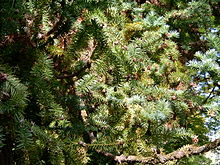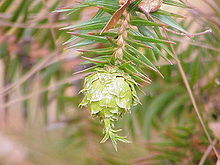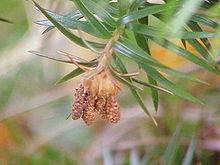- Cunninghamia
-
Cunninghamia 
Cunninghamia lanceolata Scientific classification Kingdom: Plantae Division: Pinophyta Class: Pinopsida Order: Pinales Family: Cupressaceae Genus: Cunninghamia
R.Br.Species Cunninghamia konishii Hayata
Cunninghamia lanceolata (Lamb.) Hook.The genus Cunninghamia is a genus of one or two species of evergreen coniferous trees in the cypress family Cupressaceae. They are native to China, Taiwan and northern Vietnam, where they may reach 50–55 m in height.
The general shape of the tree is conical with tiered, horizontal branches that are often somewhat pendulous toward the tips. In vernacular use, it is most often known as Cunninghamia, but is also sometimes called "China-fir" (though it is not a fir).
The two species are very similar, and recent genetic evidence strongly suggests they should be merged into one species.[citation needed] As C. lanceolata was the first name published, this name takes priority when the two are combined. In the past, the genus was usually treated in the family Taxodiaceae, but this family is now included within the Cupressaceae. A few botanists have also treated it in a family of its own, Cunninghamiaceae, but this is not widely followed.
Cunninghamia bears softly spined, leathery, stiff, green to blue-green needle-like leaves that spiral around the stem with an upward arch; they are 2–7 cm long and 3–5 mm broad at the base, and bear two white or greenish-white stomatal bands underneath and sometimes also above. The foliage may turn bronze-tinted in very cold winter weather.
The cones are small and inconspicuous at pollination in late winter, the pollen cones in clusters of 10–30 together, the female cones singly or 2–3 together.
The seed cones mature in 7–8 months to 2.5–4.5 cm long, ovoid to globose, with spirally arranged scales; each scale bears 3–5 seeds. They are often proliferous (with a vegetative shoot growing on beyond the tip of the cone) on cultivated trees; this is rare in wild trees, and may be a cultivar selected for easy vegetative propagation for use in forestry plantations.
As the tree grows its trunk tends to sucker around the base, particularly following damage to the stem or roots, and it then may grow in a multi-trunked form. Brown bark of mature trees peels off in strips to reveal reddish-brown inner bark. Older specimens often look ragged, as the old needles may cling to stems for up to 5 years.
It is a prized timber tree in China, producing soft, highly durable scented wood similar to that of Coast Redwood and Sugi. It is used in particular for manufacture of coffins and in temple building where the scent is valued. The genus name Cunninghamia honours Dr. James Cunningham, a British doctor who introduced this species into cultivation in 1702. It is grown as an ornamental tree in parks and large gardens, where it typically reaches a height of 15–30 m.
This tree can be mistaken for the rare Torreya taxifolia, one visible difference being the Cunninghamia's bronze autumn branches which are shed and pile beneath it, as well as the propensity for this tree to have more than one trunk. The Torreya is known as "Florida's gopher wood," as well as "stinking cedar" and the crushed leaves some say smell like tomato, whereas the Cunninghamia leaves do not smell.
Cunnighamia was once also an American genus.[1]
References
- ^ for example Orr, Elizabeth L. and William N, Orr 2009 Oregon Fossils: Second Edition, Oregon State University Press; 2 edition ISBN 0870715739 ISBN 978-0870715730
External links
Categories:
Wikimedia Foundation. 2010.


